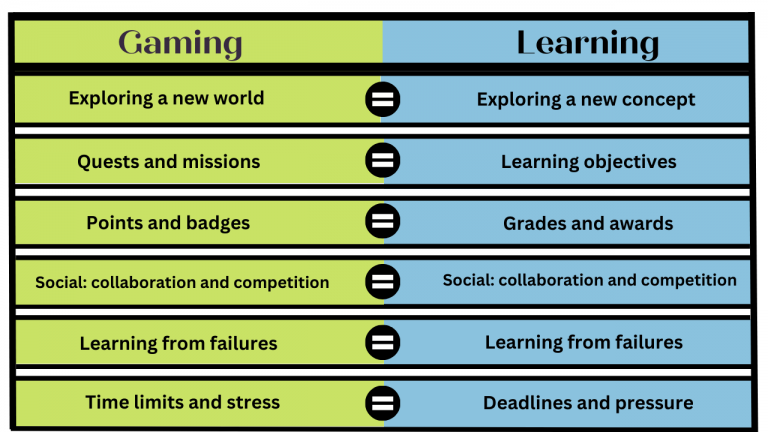
What is Gamification?
Gamification is the use of gaming elements to improve motivation and performance in the classroom. Overall benefits include:
• Encourages friendly competition
• Establishes goals
• Offers incentives
• Increases student enjoyment
Hurix (2020) explains, “successful gamification in education involves introducing mechanics and elements of games strategically into lesson planning.” At first, gamifying student learning may seem far off. However, both gaming and learning concepts have lateral connections to each other.

Table adapted from “Introduction to the use of gamification in Higher Education: Part 1” by Wang (2021).
You can integrate gamification into your course at different intensities. An instructor can choose to incorporate little to complete infusion of gaming. Low integration of gaming elements in the classroom is a less comprehensive approach to gamification in which gaming elements are integrated into the learning environment in order to enhance the learning experience. You may already include ed-tech tools that support low integration of gamification.
A complete infusion of the gamification experience is structuring a course as a game, with elements such as classroom rules and rewards, leaderboards, and badges for achievements.

Learning Tools with Gamification
Many educational technology tools already offer gaming features in their product, such as the “Time to Climb” quiz game in Nearpod or “Space Race” in Socrative. Some products offer course content embedded into the game, such as Minecraft for Education which provides students with tools to learn coding and problem-solving situations. Classcraft is a program that offers instructors a platform to structure a course as an RPG (role-playing game) experience, which features tools for classroom management, assessment building, and leaderboards.
Other tools include Quizzizz, Kahoot!, Socrative, Blooket, etc.
View how our own faculty member Dr. Patrick Sheridan integrated gamification through Padlet to create a digital escape room for his chemistry courses. (Escape Room Padlets Part 1; Escape Room Padlets Part 2)
During the Game
By integrating game elements such as rewards, points, and leaderboards into the classroom, students are encouraged to stay motivated and engaged in their learning. Additionally, gamification offers opportunities for students to develop their problem-solving and critical thinking skills, as well as collaboration and communication skills, which can be invaluable in their future careers.
Benefits of Gamification
• Increased student engagement and motivation
• Increases focus on tasks
• Improves learning retention and critical thinking skills
• Offers real-time feedback and reinforcement
• Supports student collaboration and social skills
What Happens After the Game?
Gamifying a course offers benefits regarding data. Many tools make the collection of student data easier by providing different forms of analysis. Collecting student data allows educators to address students independently or as a group based on identified learning gaps or the misconceptions they may have about the course content. Educators can apply differentiated learning strategies, activities, or methods to engage student learning and close learning gaps. Overall, data analysis helps educators reflect on what practices worked and did not, what actions could be changed, or what can be kept.
Reference
Haiken, M. (2021, February 12). 5 ways to gamify your classroom. ISTE. Retrieved December 2, 2022, from https://www.iste.org/explore/In-the-classroom/5-ways-to-gamify-your-classroom#:~:text=Gamification%20is%20about%20transforming%20the,student%20understanding%20of%20subject%20matter.
Hurix. (2020, October 24). Gamification: 5 effective ways to gamify learning in higher education. Hurix Digital. Retrieved from https://www.hurix.com/gamification-gamify-learning-higher-education/
Wang, Z. (2021, November 23). Introduction to the use of gamification in Higher Education: Part 1. Academic Technology Solutions. Retrieved from –The University of Chicago
Learn more about using gamification in your courses with these resources:
Game show classroom: Comparing Kahoot!, Quizizz, Quizlet Live and Gimkit
- The Inspiration Your Classroom Needs – Podcast
- Introduction to the Use of Gamification in Higher Education: Part 1 | Academic Technology Solutions (uchicago.edu)
- Gamification and Game-Based Learning | Centre for Teaching Excellence | University of Waterloo (uwaterloo.ca)
- Episode 105: Playful Lectures: How and Why You Should Integrate Play i – Barbi Honeycutt, PhD
Learn more about Gamification from CTLE’s Library and Teaching Resources:
- Gamification of Learning and Instruction: Game-based Methods and Strategies for Training and Education by Karl M. Kapp
- 40+ Free Digital Escape rooms ( plus a step by step guide for creating your own)


